Gerhard Heintzman upright piano, serial #25465, circa 1913
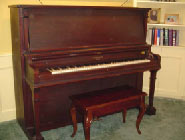
Structure:
- Pin Block – fair condition
- Soundboard – very good condition
- Tenor/Treble Bridges – good condition
- Bass Bridge – fair condition
- Plates – good condition
- Pedals – fair condition
Recommendations:
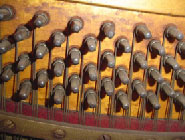
The tuning pins in the pin block are the original size two pins. They are loose and must be replaced with nickel-plated size four pins in order for the piano to hold tune at concert pitch A440.
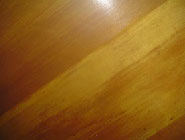
The soundboard is made of high quality spruce.

The tenor and treble bridges are in good condition. The contact point of the bridges and the strings must be re-dagged with graphite to allow the strings to slide properly over the bridge when the piano is being tuned.
The bass bridge has hairline cracks and does not have the proper amount of down bearing. It must be re-capped with rock maple, re-dagged and re-pinned.
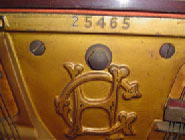
The plate is in very good condition. It will be cleaned and re-felted before the piano is re-strung. All plate screws will be polished.

The pedals must be re-felted, polished and regulated.
Action:
- Wound Strings – poor condition
- Wire Strings – poor condition
- Hammers – fair condition
- Dampers – fair condition
- Ivories/Ebonies – fair condition
- Other Action – fair condition
Recommendations:
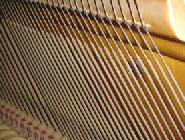
The wound strings have lost their tone quality and must be replaced with custom-made wound copper strings, after the bass bridge is repaired and when the piano is re-pinned.
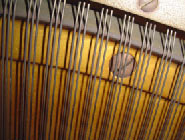
The wire strings are the original and must be replaced with new German high quality wire when the piano is re-pinned.
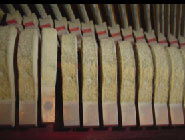
The hammers are the original. They are worn and have deep grooves on the striking point. They must be replaced with new German hammers.
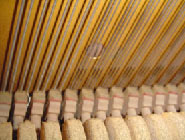
The damper felts must be replaced after the piano is re-strung. The new damper felts in the lower tenor section should not be flat felt. They will be tri-chord felt that is in the shape of a ‘W’. This type of felt will mute the strings properly.
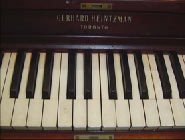
The ivories and ebonies are beautiful. They must be cleaned, polished re-bushed, leveled and spaced, in order for the piano player to feel an even touch.
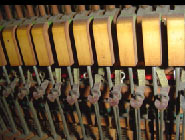
All the other action parts must be tightened and regulated. The thin cloths/felts and the springs are worn and must be replaced.
Cabinet:
- Finish – fair condition
- Bench – fair condition
Recommendations:

The cabinet is stunning. It is made with Brazilian mahogany, a type of veneer that is no longer available today. It should be stripped and refinished. All hardware will be polished to look like new and all original cloths/felts and rubber buttons will be replaced. The bench does not match the piano and the height is undesirable. A duet bench should be purchased and refinished to match the piano.
Conclusion:
This assessment presents a comprehensive account of the problems with this piano, and includes a summary of recommendations for work to be done.
This instrument is almost one hundred years old. When refurbished, it will be a superior instrument, and more valuable than most new pianos sold today.
We look forward to rebuilding your piano to provide you with many years of service and enjoyment.
Appraisal
The Gerhard Heintzman upright piano, serial #25465, circa 1913 is presently valued at $500. Once the piano is completely rebuilt, its replacement value would be $15,000.


